Wildlife of Chile
The wildlife of Chile encompasses a diverse range of animals and plants, a condition is attributed to the country's slender and elongated shape, which spans a wide range of latitude, and also its altitude, ranging from the windswept coastline of the Pacific coast on the west to northern Andes to the sub-Antarctic, high Andes mountains in the east. There are many distinct ecosystems.
Chile, often called "The spine of South America", has 100 protected areas covering a total area of 14.5 million hectares (20% of the country) in 36 National parks, 49 National Reserves, and 15 National Monuments. In the southern part of Chile, 50 percent of the flora (part of temperate rain forest called the Valdivian forests) is endemic which is a unique feature in the world. Lapageria rosea (Chilean bellflower) is the national flower, Andean condor, (Vultur gryphus) (NT), is the national bird, and taruca or South Andean huemul, is the national animal of Chile. Legally, wildlife in Chile is res nullius.[1]
Geography
From the wildlife angle, Chile in Southern South America stretches in a north-south direction, called the spine of South America, has terrestrial borders with Argentina and Peru, and has long coast line of 6,435 km (3,999 miles) on the South Pacific Ocean. The Atacama Desert is the most arid desert in the world. The Ojos del Salado, a crater lake which is the world's highest lake (at 6,390 metres (20,960 ft)) is located here.[2]
Climate
In northern Chile there is the harsh Atacama desert with typical desertic wildlife such as cacti. In the country's middle part, there is a temperate Mediterranean climate, while the south has cold and moist mountainous regions and numerous islands.[2]
Enabling laws
The first law addressing the capture and use of wild animals was contained in the Civil Code of 1888.[1] Chile has brought nearly 20% of its terrestrial area under conservation protection laws and 3.19% of its marine jurisdiction is also under protection. The first national park was created in 1925 following an earlier protected area created in 1907. But it was the Ley de Bosques (1931) which permitted the establishment of NP, reserves and natural monuments.[1] Since then several agencies both government (at the central and regional level) and private agencies have been involved in biodiversity conservation and preservation. Until 1984, the conservation actions of creation and management of protected areas was with the Agriculture and Livestock Service (SAG), a government body. In 1970, the Chilean Forest Service (CONAF) was given the responsibility to create and manage protected areas. A centralized system for preservation of the biodiversity of Chile was, however, created in 1984 only, under the Decree Law 18,362 which specified the creation of protected areas as "the continuity of evolutionary processes, animal migrations, genetic flow patterns and the regulation of the environment". Under this decree a national public system titled Sistema Nacional deÁreas Silvestres Protegidas (SNASPE) was established and charged with the task of setting up parks and reserves under set guidelines for management and conservation. The SNASPE followed the IUCN guidelines to set up protected areas under four categories of Virgin Regional Reserves, National Parks, Natural Monuments, and National Reserves. Complementing the actions of SNAPE are initiatives taken by private agencies to protect specific areas. Both actions are tended towards ecotourism. As biodiversity outside the limits of the protected areas is equally important, proposals have been mooted to promote this activity.[3]
.svg.png)
Laws regulating exploitation of wildlife are in force since 1888 which have been improved upon since the 1990s, with regulations of 1993 being the most recent and stringent. This has resulted in almost total check over hunting and commercialization of vertebrates, except for exploitation of bird species, two deer (introduced), vertebrate pests, and the inducted lagomorphs species of European hare (Lepus timidus) and European rabbit (Oryctolagus cuniculus).[4]
While the laws have provided protection to reptiles and amphibians, animals with fur cover and game species of both birds and mammals are exploited to a reasonable level. However, cross border illegal traffic still persists and Chile acts as a conduit for illegal trafficking in animals from other South American countries and the law enforcement in this regard is lax.[4]
Protected areas
With respect to conservation of flora and fauna, the protected areas are identified in the country's 15 administrative regions, plus the Metropolitan area and the M. de Santiago, which are listed in alphabetical order (each region's serial number—based on information sourced to Corporación Nacional Forestal (CONAF)— appears in parentheses):[5]
- Aysén del General Carlos Ibáñez del Campo (XI)
- Antofagasta (II)
- Araucanía (IX)
- Arica y Parinacota (XV)
- Atacama (III)
- Bío Bío (VIII)
- Coquimbo (IV)
- Libertador Bernardo O'Higgins (VI)
- Los Lagos (X)
- Los Ríos (XIV)
- M. de Santiago
- Magallanes y la Antártica Chilena (XII)
- Maule (VII)
- Metropolitana (R.M.)
- Tarapacá (I)
- Valparaíso (V)
The total number of protected areas in the above listed regions are 100 covering a total area of 14.5 million hectares (20% of the country) in 36 National Parks, 49 National Reserves, and 15 National Monuments. The monuments category accounts for a minuscule percentage of 0.01 percent with the other two categories accounting 99.9%.[5]
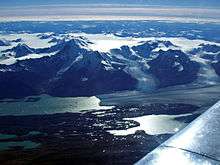
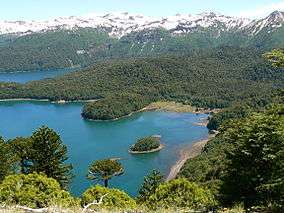
In terms of world statistics of area covered under protection, Chile has the second place in Latin America and seventh place in the world. However, the distribution of the protected area in the country is highly uneven with two of the 15 administrative regions garnering 84% of the protected area with the southern regions XI and XII having the major share of about 50% of the total area which adjoins the forest and protected areas of the Argentinean Andes of Patagonia. In the remaining regions, the protected area covered is only 4.4% of total area which is less than the accepted international norm of 5%. The protected areas are also governed by the "ice and rock" criterion adopted in the United States Wilderness System. Under this criteria, about 23% of the total area of SNASPE is covered by ice fields and other land types which have no vegetation and least habitation.[3] Apart from the 100 terrestrial protected areas which also partly include some marine areas, now 75 new critical bird areas of marine birdlife have been identified by BirdLife International. The Important Bird Areas (IBA) cover the "cliffs of Africa, the bays of Coquimbo, Mejillones, the mouths of Biobío and Maipu rivers, the Alejandro Selkirk islands, Choros, Damas, Punta de Choros, and Parque Nacional Cabo de Hornos."[6]
Flora
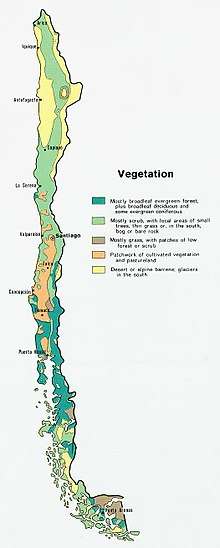
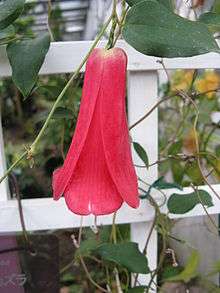
the national flower
The country's flora is composed of "56 orders, 181 families, 837 genera, and about 4,295 species" with large numbers in terms of genera and species from the families Asteraceae, Poaceae, Fabaceae, and Solanaceae.[7] The land is divided into latitudes sections which dictate the country's vegetation; the soil conditions of the lands and the climatic conditions are key factors in this respect. In the northern desert region (Atacama Desert, the driest place on Earth[8]) which is the desert region of sand there is no precipitation at all but it still sustains not only vegetation but also fauna; the coastal fogs moving up sustain them. The desert vegetation consists of a spiny acacia tree, varieties of cacti as well as shrubs and spiny brambles. In the high plateau area of northern Chile, the common species of flora are llareta and grasses of ichu and tola varieties. The semiarid region of central Chile, cacti, espino and algarrobo hardwood, and Adesmia shrubs are the notable flora. In the humid and temperate region of central Chile, vegetation is defined by the term matorral which consists of thick growth of hardwoods, shrubs, cacti, and green grass; however the vegetation is thinning due to heavy anthropogenic pressure on land. South of the Biobío River, mixed deciduous forest and evergreen trees are the common vegetation types; the species reported are rauli or southern cedar, the roble beech, the ulmo(an evergreen shrub), and the evergreen laurel. The vegetation types in the western slopes of the Andes are formed of thick forests of monkey puzzle tree (Chile pine). The Lake District of Chile has dense rain forests of timber species. To the south of the lake, the dominant vegetation consists of Antarctic beech, the Chilean cedar, and the giant alerce (this tree in southern Chile is reported to be 3000 years old and is the "second largest living organism in the world"[9][10]). In the Chilean Patagonia and Tierra del Fuego island, due to weather conditions only dwarf variety of southern beech and hard grasses are noted.[9]
Of all the floral vegetation in Chile, the pristine floral vegetation of sub-Antarctic forests (including deciduous lenga forests, peat bogs, Andean meadows) are found in the Tierra del Fuego (meaning "Land of Fire"), in the eastern part in Chile and the western part in Argentina, part of which is the Bernardo O'Higgins National Park, which is the largest protected areas in South America.[11] In the southern part of Chile, 50 percent of the flora (part of temperate rain forest called the Valdivian forests) is endemic, a unique feature in the world.[10]
Lapageria rosea (Chilean bellflower), a twining climber, considered as one of the most beautiful flowering vines in the world, is the national flower of Chile.[12][13]
Fauna
Mammals
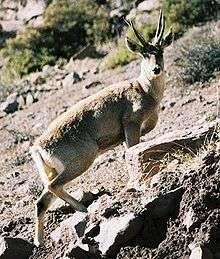
In view of its geographic setting with formidable High Andes mountain on its eastern border and the arid deserts of north, deterring movement from its neighbouring countries, the terrestrial mammals species in Chile are limited to 103, out of a total mammal species count of about 148. The land mammals are mostly nocturnal and avoid human contact. National parks, which provide protection to the mammals, are the most likely locations where these animals can be seen. There are 18 endemic mammal species. Marine mammals (such as whales, otters, sea lions, dolphins) and birds are quite easily seen along the long coastline in the Pacific Ocean to the west of the country.[14] Of the more than 600 vertebrate species in the country, only two dozen are considered to be exotic.[15] Notable mammal species include guanacos (a form of the wild llama), feral minks, armadillos, culpeo (fox), and opossums. Species reported in Southern Chile are pudú (world's smallest deer), and the opossum-like monito del monte, which is a living fossil.[10] The Patagonian puma, called mountain lion or cougar in North America, is found throughout Chile and its population (once hunted indiscriminately) has been helped by protection provided by the government.[16]
Native marine mammals include elephant seals and sea lions.[11] Blue whales (in the Gulf of Corcovado) (the largest mammal in the world), humpback, sei and sperm whales, sea otters, and dolphin species are also reported.
Birds
The national bird of Chile is the Andean condor[17] The total avifauna species in Chile as reported by BirdLife International, as of 2012, number 530, including 14 endemic species (two breeding in Chile), 37 globally threatened species, and 7 introduced species.[18] The globally endangered, endemic and introduced species are as follows:[18]


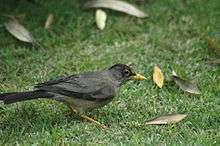
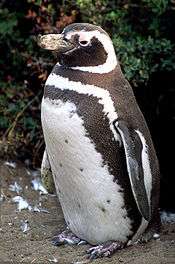
Critically endangered
- Podiceps gallardoi (hooded grebe)
- Phoebastria irrorata (waved albatross)
- Pterodroma magentae (magenta petrel)
- Pterodroma phaeopygia (Galapagos petrel)
- Numenius borealis (Eskimo curlew) may be extinct
Endangered
- Phoebetria fusca (sooty albatross)
- Pterodroma atrata (Henderson petrel)
- Pterodroma alba (Phoenix petrel)
- Nesofregetta fuliginosa (Polynesian storm-petrel)
- Pelecanoides garnotii (Peruvian diving-petrel)
- Phalacrocorax gaimardi (red-legged cormorant)
- Phalacrocorax bougainvillii (Magellan cormorant)
- Sternula lorata (Peruvian tern)
Near threatened
- Rhea pennata (lesser rhea)
- Speculanas specularis (spectacled duck)
- Phoenicopterus chilensis (Chilean flamingo)
- Phoenicoparrus jamesi (James's flamingo)
- Aptenodytes forsteri (emperor penguin)
- Pygoscelis adeliae (Adelie penguin)
- Pygoscelis papua (gentoo penguin)
- Spheniscus magellanicus (Magellanic penguin)
- Thalassarche bulleri (Buller's albatross)
- Phoebetria palpebrata (light-mantled albatross)
- Pterodroma ultima (Murphy's petrel)
- Pterodroma inexpectata (mottled petrel)
- Procellaria cinerea (gray petrel)
- Puffinus griseus (sooty shearwater)
- Pelecanus thagus (Peruvian pelican)
- Vultur gryphus (Andean condor)
- Buteo ventralis (rufous-tailed hawk)
- Fulica cornuta (horned coot)
- Phegornis mitchellii (diademed sandpiper-plover)
- Pluvianellus socialis (Magellanic plover)
- Calidris pusilla (semipalmated sandpiper)
- Tryngites subruficollis (buff-breasted sandpiper)
- Gallinago stricklandii (Fuegian snipe)
- Larosterna inca (Inca tern)
- Thalasseus elegans (elegant tern)
- Chaetura pelagica (chimney swift)
- Phalcoboenus australis (striated caracara )
- Falco deiroleucus (orange-breasted falcon)
- Aratinga erythrogenys (red-masked parakeet )
- Anairetes fernandezianus (Juan Fernandez tit-tyrant)
- Oreomanes fraseri (giant conebill)
- Xenospingus concolor (slender-billed finch)
Vulnerable
- Tachyeres leucocephalus (white-headed steamer-duck)
- Phoenicoparrus andinus (Andean flamingo)
- Spheniscus humboldti (Humboldt penguin)
- Eudyptes chrysolophus (macaroni penguin)
- Eudyptes schlegeli (royal penguin)
- Thalassarche chrysostoma (gray-headed albatross)
- Thalassarche salvini (Salvin's albatross)
- Thalassarche eremita (Chatham albatross)
- Pterodroma externa (Juan Fernandez petrel)
- Pterodroma cookii (Cook's petrel)
- Pterodroma defilippiana (Masatierra petrel)
- Procellaria aequinoctialis (white-chinned petrel)
- Procellaria parkinsoni (Parkinson's petrel)
- Procellaria westlandica (Westland petrel)
- Puffinus creatopus (pink-footed shearwater)
- Puffinus bulleri (Buller's shearwater)
- Rallus antarcticus (austral rail)
- Numenius phaeopus or N. p. hudsonicus (whimbrel or Hudsonian curlew)
- Agriornis albicauda (white-tailed shrike-tyrant)
- Progne murphyi (southern martin)
- Conirostrum tamarugense (tamarugo conebill)
Endemic
- Nothoprocta perdicaria (ornate tinamou)
- Pterodroma longirostris (Stejneger's petrel) breeding type (V)
- Eulidia yarrellii (Chilean woodstar) (EN)
- Enicognathus leptorhynchus (slender-billed parakeet )
- Pteroptochos castaneus (chestnut-throated huet-huet)
- Pteroptochos megapodius (moustached turca)
- Scelorchilus albicollis (white-throated tapaculo)
- Scytalopus fuscus (dusky tapaculo)
- Aphrastura masafuerae (Mas Afuera rayadito) (CR)
- Sephanoides fernandensis (Juan Fernandez firecrown) (CR)
- Mimus thenca (Chilean mockingbird)
Non-marine molluscs
A number of species of non-marine molluscs are found in the wild in Chile. Native Orthalicidae include 29 species of genus Bostryx and 12 species of genus Plectostylus.[19]
Marine molluscs

The marine molluscs of Chile number 1070 species, including gastropods such as limpets, snails and sea slugs; bivalves such as clams, oysters, mussels and scallops; and cephalopods such as octopuses, squids and cuttlefish.[20]
Threats
There are many reasons for the decline of fauna and flora in Chile. These generally relate to encroachment of land for agriculture and mining (widespread deforestation), hunting for felt, food and trade of animals, and attack by other animals and birds. It is reported that nearly 33% of the mammals species face threat of extinction.[2][14]
In the marine area, the threats posed are from industrial fishing (salmon farming and cultured mussels) and aquaculture particularly in the Gulf of Corcovado, intensive exploitation of marine resources, with large maritime traffic of trawls, associated fishing.[10]
Conservation
In this context of mammals species in Central Chile, a highly populated region, is of conservation concern. Even in the arid areas of northern Chile, the concern for conservation is essential. Chilean authorities, with international assistance, have made progress in addressing these problems but much remains to be done that will require continued international assistance if many unique forms are to be preserved.[21]
Conservation of wildlife is achieved through protected areas set up and managed by both the government organizations such as the SNAPPE and its implementation wing the CONAF, and also through private initiatives. Commercial exploitation is controlled by the Convention on International Trade in Endangered Species (CITES) of IUCN to which Chile is a signatory and CITES Annexure II gives the list of endangered species.[14] International assistance has contributed richly in this activity.[21]
As part of conservation of its wildlife, Chile is signatory (but not ratified) to the international agreements/protocols/Conventions /Laws such as the Antarctic-Environmental Protocol, Antarctic-Marine Living Resources, Antarctic Seals, Antarctic Treaty, Biodiversity, Climate Change, Climate Change-Kyoto Protocol, Desertification, Endangered Species, Environmental Modification, Hazardous Wastes, Law of the Sea, Marine Dumping, Ozone Layer Protection, Ship Pollution, Wetlands, and Whaling.[2]
Gallery
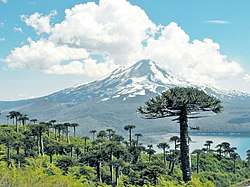 Araucaria araucana trees in Conguillío National Park
Araucaria araucana trees in Conguillío National Park- Pudú in Chile
- Chilla fox, common in the region
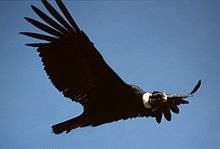 Andean condor (Vultur gryphus), the national bird of Chile
Andean condor (Vultur gryphus), the national bird of Chile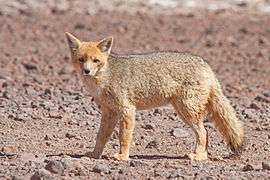 Lycalopex culpaeus, a culpeo or Andean fox
Lycalopex culpaeus, a culpeo or Andean fox A guanaco in northern Chile
A guanaco in northern Chile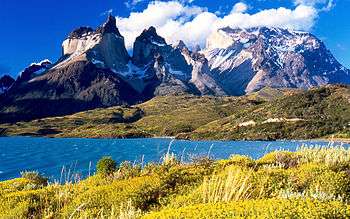 Torres del Paine from Lake Pehoé, Torres del Paine National Park, Chile
Torres del Paine from Lake Pehoé, Torres del Paine National Park, Chile
See also
Bibliography
- Chester, Sharon (19 April 2010). A Wildlife Guide to Chile: Continental Chile, Chilean Antarctica, Easter Island, Juan Fernandez Archipelago. Princeton University Press. ISBN 978-1-4008-3150-0.CS1 maint: ref=harv (link)
- Conover, Michael R. (12 December 2010). Resolving Human-Wildlife Conflicts: The Science of Wildlife Damage Management. Taylor & Francis. ISBN 978-1-56670-538-7.CS1 maint: ref=harv (link)
- Gordon, Iain J. (13 January 2009). The Vicuna: The Theory and Practice of Community Based Wildlife Management. Springer. ISBN 978-0-387-09476-2.CS1 maint: ref=harv (link)
- Moreira-Muñoz, Andrés (19 January 2011). Plant Geography of Chile. Springer. ISBN 978-90-481-8748-5.CS1 maint: ref=harv (link)
References
- Gordon 2009, p. 71.
- "The World Factbook:Chile". Central Intelligence Agency (CIA). Retrieved 29 July 2013.
- Pauchard, Villarroel (2002). "Protected Areas in Chile:History, Current Status, and Challenge: Journal22(4)" (PDF). Natural Areas Journal: School of Forestry University of Montana. Retrieved 22 July 2013. Cite journal requires
|journal=(help) - Iriartea, J. Agustin; Feinsingerb, Peter; Jaksic, Fabian M. (July–August 1997). "Trends in wildlife use and trade in Chile". Biological Conservation. Elsevier. 81 (1–2): 9–20. doi:10.1016/S0006-3207(96)00150-4. ISSN 0006-3207.
- "Parks, Reserves, and Other Protected Areas in Chile". Portal about Parks in the World. Retrieved 29 July 2013.
- "In Chile 75 new critical marine bird conservation sites named". Thisischile.cl. 6 December 2012. Retrieved 22 July 2013.
- Moreira-Muñoz 2011, p. 46.
- "Rock-strewn wilderness". BBC Travel News. Retrieved 22 July 2013.
- "Plant and Animal Life". Encyclopædia Britannica. Retrieved 22 July 2013.
- "Southern Chile". World Wild Life Organization. Retrieved 22 July 2013.
- "Bernardo O'Higgins National Park". Official website of Bernardo O'Higgins National Park. Retrieved 26 July 2013.
- "Lapageria rosea AGM". Royal Horticultural Society. Retrieved 29 July 2013.
- "Rare and exotic plants & seeds". Strange Wonderful Things.com. Retrieved 29 July 2013.
- Chester 2010, p. 291.
- Conover 2010, p. 144.
- "Patagonia Wildlife Photos". National Geographic. Retrieved 26 July 2013.
- "Birds of Chile, Checklist of the Birds of Chile; The Chilean Birdlist:Pájaros / Aves De Chile". Birdlist Organization. Retrieved 22 July 2013.
- "Avibase - Bird Checklists of the World, Chile". Avi Base Eco organization. Retrieved 22 July 2013.
- "Chilean Orthalicidae" (PDF). Ashbreure. Retrieved 29 July 2013.
- "Moluscos marinos de Chile". Moluscoschilenos. Retrieved 29 July 2013.
- Miller, Sterling D.; Rottmann, Jurgen; Raedeke, Kenneth J.; Taber, Richard D. (1983). "Endangered mammals of Chile: Status and conservation". Biological Conservation. 25 (4): 335–352. doi:10.1016/0006-3207(83)90069-1.
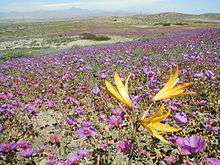
_(Peninsula_de_Valdes%2C_Jan_1984).jpg)